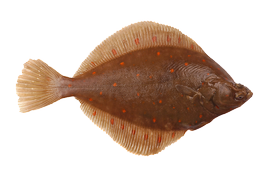
FLOUNDER/PLAICE/DAB
The flounder family includes plaice, European flounder and common dab. They are small and very similar in appearance. The plaice with its red spots is the easiest to recognize.
Fish facts
Plaice, European flounder and common dab can have several different names depending on where they are caught. Flounder are sometimes known as fluke.
How to cook flounder
Plaice and other flounders taste best fried whole. Remove the skin on the top side if you prefer. Here’s how: First cut off the head – the guts just under the head will come away too. Put the tip of the knife under the skin where the head was. Carefully pull the skin off backwards in one piece. Use newspaper to get a better grip.
There’s no need to remove the white skin on the underside. After cooking it will take on roughly the same delicate consistency as the flesh of the fish.
Some gourmets think just under the skin is where you’ll find most of the flavor so it shouldn’t be removed. It’s up to you.
Make sure your pan is hot and that the fish is dry so you get a crispy, browned result. Don’t try to fry several flounders at a time.
These mild-tasting flatfish benefit from the balance you get from a mix of diced beetroot (sweet and sour) and capers (salty). Let the chopped vegetables brown for a minute or two in butter (fat) on a low heat. Sour apple and salty ham/bacon can provide the right balance too.
The classic
Flounder fried whole, coated in rye flour, with melted butter, lemon and chopped parsley. Ideally with a sea view and a cold beer.
Conservation status:
MSC-certified flounder, dab or plaice are green. The fish need to be more than 20 cm long.








